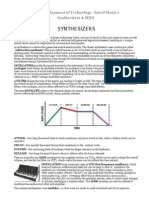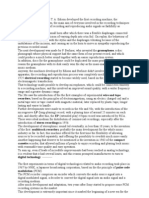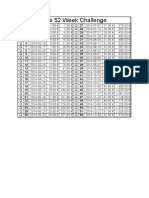0 ratings0% found this document useful (0 votes)
25 viewsMusic IV (Report)
Music IV (Report)
Uploaded by
Antonio IJMusic sequencers and drum machines began being used in the mid-20th century to produce popular music. In 1980, MIDI was created to standardize the interface between instruments and computers. MIDI allowed control of multiple devices remotely and synchronously. The first commercial digital synthesizer, the Fairlight CMI, was released in 1979 and was the first practical polyphonic digital synthesizer. The rise of home computers in the 80s and 90s led to the emergence of chiptunes, which used computer sound chips to synthesize and sequence music in real time.
Copyright:
© All Rights Reserved
Available Formats
Download as PPTX, PDF, TXT or read online from Scribd
Music IV (Report)
Music IV (Report)
Uploaded by
Antonio IJ0 ratings0% found this document useful (0 votes)
25 views7 pagesMusic sequencers and drum machines began being used in the mid-20th century to produce popular music. In 1980, MIDI was created to standardize the interface between instruments and computers. MIDI allowed control of multiple devices remotely and synchronously. The first commercial digital synthesizer, the Fairlight CMI, was released in 1979 and was the first practical polyphonic digital synthesizer. The rise of home computers in the 80s and 90s led to the emergence of chiptunes, which used computer sound chips to synthesize and sequence music in real time.
Original Description:
instructional materials
Copyright
© © All Rights Reserved
Available Formats
PPTX, PDF, TXT or read online from Scribd
Share this document
Did you find this document useful?
Is this content inappropriate?
Music sequencers and drum machines began being used in the mid-20th century to produce popular music. In 1980, MIDI was created to standardize the interface between instruments and computers. MIDI allowed control of multiple devices remotely and synchronously. The first commercial digital synthesizer, the Fairlight CMI, was released in 1979 and was the first practical polyphonic digital synthesizer. The rise of home computers in the 80s and 90s led to the emergence of chiptunes, which used computer sound chips to synthesize and sequence music in real time.
Copyright:
© All Rights Reserved
Available Formats
Download as PPTX, PDF, TXT or read online from Scribd
Download as pptx, pdf, or txt
0 ratings0% found this document useful (0 votes)
25 views7 pagesMusic IV (Report)
Music IV (Report)
Uploaded by
Antonio IJMusic sequencers and drum machines began being used in the mid-20th century to produce popular music. In 1980, MIDI was created to standardize the interface between instruments and computers. MIDI allowed control of multiple devices remotely and synchronously. The first commercial digital synthesizer, the Fairlight CMI, was released in 1979 and was the first practical polyphonic digital synthesizer. The rise of home computers in the 80s and 90s led to the emergence of chiptunes, which used computer sound chips to synthesize and sequence music in real time.
Copyright:
© All Rights Reserved
Available Formats
Download as PPTX, PDF, TXT or read online from Scribd
Download as pptx, pdf, or txt
You are on page 1of 7
Sequencers and Drum machines
Music sequencers began being used around the
mid 20th century, and Tomita's albums in mid-
1970s being later examples.In 1978, Yellow Magic
Orchestra were using computer-based technology
in conjunction with a synthesiser to produce
popular music,making their early use of
the microprocessor-based Roland MC-8
Microcomposer sequencer.
Drum machines, also known as rhythm
machines, also began being used around the
late-1950s, with a later example being Osamu
Kitajima's progressive rock
album Benzaiten (1974), which used a rhythm
machine along with electronic drums and a
synthesizer.
Birth of MIDI
In 1980, a group of musicians and music
merchants met to standardize an interface that
new instruments could use to communicate
control instructions with other instruments and
computers. This standard was dubbed Musical
Instrument Digital Interface (MIDI) and resulted
from a collaboration between leading
manufacturers.
MIDI technology allows a single keystroke, control
wheel motion, pedal movement, or command
from a microcomputer to activate every device in
the studio remotely and in synchrony, with each
device responding according to conditions
predetermined by the composer.
Digital synthesis
The first commercial digital synthesizer to be
released would be the
Australian Fairlight company's Fairlight
CMI (Computer Musical Instrument) in 1979, as
the first practical polyphonic digital
synthesizer/sampler system.
Chiptunes
The new availability of low-cost home computers in
the 80s and 90s led to the rise of chiptunes. Chiptunes,
chipmusic, or chip music is music written in sound
formats where many of the sound textures are
synthesized or sequenced in real time by
a computer or video game console sound chip,
sometimes including sample-based synthesis and low
bit sample playback.
Many chip music devices featured synthesizers in
tandem with low rate sample playback.The
characteristic lo-fi sound of chip music was initially
the result of early sound cards' technical
limitations; however, the sound has since become
sought after in its own right.
You might also like
- Understanding Audio: Getting the Most Out of Your Project or Professional Recording StudioFrom EverandUnderstanding Audio: Getting the Most Out of Your Project or Professional Recording StudioRating: 4.5 out of 5 stars4.5/5 (10)
- The Fundamentals of Synthesizer ProgrammingFrom EverandThe Fundamentals of Synthesizer ProgrammingRating: 1.5 out of 5 stars1.5/5 (2)
- The Beginner's Guide To MidiDocument11 pagesThe Beginner's Guide To MidiAnda100% (7)
- The Cambridge Guide To Asian TheatreDocument10 pagesThe Cambridge Guide To Asian TheatreAntonio IJNo ratings yet
- 05 - MidiDocument21 pages05 - MidiSteveDFNo ratings yet
- The Development of Technology-Based Music 1 - Synths & MIDIDocument6 pagesThe Development of Technology-Based Music 1 - Synths & MIDIsimonballemusicNo ratings yet
- Beginners Synthesizer FAQDocument59 pagesBeginners Synthesizer FAQTímea KovácsNo ratings yet
- History of Sound RecordingDocument3 pagesHistory of Sound Recordinglele7591100% (1)
- Electronic MusicDocument14 pagesElectronic MusicHannah Elizabeth GarridoNo ratings yet
- Digital SynthesizerDocument11 pagesDigital Synthesizernisha akshayaNo ratings yet
- MusicWorkstation WikiDocument4 pagesMusicWorkstation WikiTamás BenyácsNo ratings yet
- SynthesizerDocument4 pagesSynthesizersonsdoedenNo ratings yet
- SynthesizerDocument14 pagesSynthesizerroroNo ratings yet
- Samplers LectureDocument4 pagesSamplers LecturebradNo ratings yet
- Additive Synthesis (Sometimes Referred To As Fourier Synthesis, As ItDocument2 pagesAdditive Synthesis (Sometimes Referred To As Fourier Synthesis, As ItdavidmesihaNo ratings yet
- Recording Technology TimelineDocument1 pageRecording Technology TimelineMatt GoochNo ratings yet
- MIDI TutorialDocument27 pagesMIDI TutorialAARON100% (1)
- Discuss The Development of Samplers and How They Shaped The Direction of Popular Music in The 1980Document2 pagesDiscuss The Development of Samplers and How They Shaped The Direction of Popular Music in The 1980mws_97No ratings yet
- Guide To MIDI (PT I) : A Brief History and Explanation of The Mystery of MIDI..Document3 pagesGuide To MIDI (PT I) : A Brief History and Explanation of The Mystery of MIDI..RagagaNo ratings yet
- Chapter 2 - Amazing InstrumentsDocument54 pagesChapter 2 - Amazing InstrumentsCristina LedfordNo ratings yet
- Chapter 2Document8 pagesChapter 2Adrian BagayanNo ratings yet
- A History of Robotic Musical InstrumentsDocument8 pagesA History of Robotic Musical InstrumentsipersferaNo ratings yet
- Sound Synthesis Theory-IntroductionDocument2 pagesSound Synthesis Theory-IntroductionagapocorpNo ratings yet
- Beginners Guide To Music Production - Musictech Musictech PDFDocument14 pagesBeginners Guide To Music Production - Musictech Musictech PDFSenthil KumarNo ratings yet
- Beginners Guide To Music Production - Musictech Musictech PDFDocument14 pagesBeginners Guide To Music Production - Musictech Musictech PDFOgwoGPNo ratings yet
- Holmes CH 33 Digital SynthsDocument10 pagesHolmes CH 33 Digital SynthsrapperspectivemediaNo ratings yet
- Ishkurs Guide To Electronic Music v2.5 Text ArchiveDocument57 pagesIshkurs Guide To Electronic Music v2.5 Text ArchiveGodAlbinoNo ratings yet
- Spectral ProcessingDocument75 pagesSpectral ProcessingGandhi WasuvitchayagitNo ratings yet
- How Has Technology Helped Develop The Music KeyboardDocument2 pagesHow Has Technology Helped Develop The Music KeyboardgadirowNo ratings yet
- Digital Synthesis of MusicDocument3 pagesDigital Synthesis of MusicVictor Hernandez MedinaNo ratings yet
- Fine Dawn of DigitalDocument22 pagesFine Dawn of DigitalTatjana GimpelNo ratings yet
- Keyboard and RecorderDocument66 pagesKeyboard and RecorderPris AtarashiiNo ratings yet
- Iconic Drum MachinesDocument6 pagesIconic Drum MachinesGizem AkmanNo ratings yet
- How Has The Computer Impacted The Music Industry?Document8 pagesHow Has The Computer Impacted The Music Industry?yourhunkieNo ratings yet
- For - The - Love - of - ChiptuneDocument24 pagesFor - The - Love - of - ChiptuneDaniel BuendíaNo ratings yet
- Tangerine Dream - Electronics & Music Maker MagazineDocument12 pagesTangerine Dream - Electronics & Music Maker Magazinecocovscarlos100% (3)
- PC SoundCard and Digital Audio History by Lyndsay Williams 1980 - 1989Document30 pagesPC SoundCard and Digital Audio History by Lyndsay Williams 1980 - 1989sensecam@gmail.comNo ratings yet
- The Development of Technology Based Music 1 Synths MIDIDocument6 pagesThe Development of Technology Based Music 1 Synths MIDIBenJohnsonNo ratings yet
- 5 Synth LMMS1Document19 pages5 Synth LMMS1hafidzmalek2412No ratings yet
- Behringer - ODYSSEY P0BNY - Product Information DocumentDocument11 pagesBehringer - ODYSSEY P0BNY - Product Information DocumentDavidNo ratings yet
- From Organs To Computer MusicDocument16 pagesFrom Organs To Computer Musicjoesh2No ratings yet
- Yamaha Synth History enDocument189 pagesYamaha Synth History enJuliano DinelliNo ratings yet
- The Desktop Music Handbook PDFDocument62 pagesThe Desktop Music Handbook PDFBiscuit_WarriorNo ratings yet
- 09 Synth HistoryDocument6 pages09 Synth HistoryAlex SantosNo ratings yet
- Carnatic Music SynthesisDocument11 pagesCarnatic Music SynthesistelugutalliNo ratings yet
- The Dawn of Commercial Digital RecordingDocument18 pagesThe Dawn of Commercial Digital RecordingRyan SchweitzerNo ratings yet
- Music Shaped by Technology - Text BookDocument12 pagesMusic Shaped by Technology - Text Bookdev.hanley.godwyn.amalan.studentNo ratings yet
- Modular SynthesizerDocument21 pagesModular SynthesizerEmmanuel UribeNo ratings yet
- Immediate Download An Anthology of Sound Chips Vol 1 Arcade Console and Home Micro Sound Chips 1977 1986 Chris Abbott Ebooks 2024Document67 pagesImmediate Download An Anthology of Sound Chips Vol 1 Arcade Console and Home Micro Sound Chips 1977 1986 Chris Abbott Ebooks 2024niakeishin9100% (1)
- 1990's - Today Write UpDocument7 pages1990's - Today Write UpCallumNo ratings yet
- Pierre Boulez and Andrew Gerzso - Computers in MusicDocument8 pagesPierre Boulez and Andrew Gerzso - Computers in MusicJorge A. Avilés100% (1)
- Mixing Desks NOTES (Music Technology Edexcel)Document3 pagesMixing Desks NOTES (Music Technology Edexcel)Alex HynesNo ratings yet
- MIDI FormatDocument560 pagesMIDI FormatJemil Mathew JosephNo ratings yet
- Lesson 3: Electronic Music: Unit 1 Music of The Twentieth CenturyDocument24 pagesLesson 3: Electronic Music: Unit 1 Music of The Twentieth CenturyMary Rose CabaldoNo ratings yet
- Quantum Computer MusicDocument10 pagesQuantum Computer Musicshreyasatsangi27No ratings yet
- Invention of MIDI (PDF) PJPMDocument1 pageInvention of MIDI (PDF) PJPMpjpcool27No ratings yet
- MIDI Short For Musical Instrument Digital Interface) Is A TechnicalDocument10 pagesMIDI Short For Musical Instrument Digital Interface) Is A TechnicalJomark CalicaranNo ratings yet
- Power Tools For Synthesizer Programming The Ultimate Reference For Sound DesignDocument228 pagesPower Tools For Synthesizer Programming The Ultimate Reference For Sound Designbolomite100% (5)
- The Insider's Guide to Home Recording: Record Music and Get PaidFrom EverandThe Insider's Guide to Home Recording: Record Music and Get PaidRating: 1 out of 5 stars1/5 (1)
- The Hip Hop Producer's Guide Book: Secrets to Sonic Success and a Profitable Music CareerFrom EverandThe Hip Hop Producer's Guide Book: Secrets to Sonic Success and a Profitable Music CareerNo ratings yet
- A Genre Analysis of The Results Section of Sociology ArticlesDocument13 pagesA Genre Analysis of The Results Section of Sociology ArticlesAntonio IJNo ratings yet
- Euro ChallengeDocument1 pageEuro ChallengeAntonio IJNo ratings yet
- Active and Passive VoiceDocument5 pagesActive and Passive VoiceAntonio IJNo ratings yet
- Analyzing Famous Speeches As Arguments: Elements of Rhetorical/Literary DevicesDocument4 pagesAnalyzing Famous Speeches As Arguments: Elements of Rhetorical/Literary DevicesAntonio IJNo ratings yet
- EsheteGemeda Part TwoDocument308 pagesEsheteGemeda Part TwoAntonio IJ100% (2)
- The Romance Mode in Philippine Literature PDFDocument19 pagesThe Romance Mode in Philippine Literature PDFAntonio IJNo ratings yet
- Voice WorksheetDocument2 pagesVoice WorksheetAntonio IJNo ratings yet
- Combining Like Terms Algebra TilesDocument28 pagesCombining Like Terms Algebra TilesAntonio IJNo ratings yet
- Sample Lazy TeacherDocument12 pagesSample Lazy TeacherAntonio IJNo ratings yet





































































